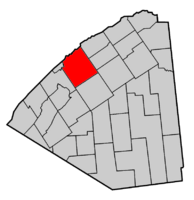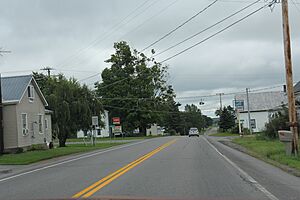Lisbon, New York facts for kids
Quick facts for kids
Lisbon, New York
|
|
|---|---|

Map highlighting Lisbon's location within St. Lawrence County.
|
|
| Country | United States |
| State | New York |
| County | St. Lawrence |
| Area | |
| • Total | 113.92 sq mi (295.04 km2) |
| • Land | 108.28 sq mi (280.44 km2) |
| • Water | 5.64 sq mi (14.60 km2) |
| Elevation | 344 ft (105 m) |
| Population
(2020)
|
|
| • Total | 4,221 |
| • Density | 37.53/sq mi (14.49/km2) |
| Time zone | UTC-5 (Eastern (EST)) |
| • Summer (DST) | UTC-4 (EDT) |
| FIPS code | 36-42631 |
| GNIS feature ID | 0979154 |
Lisbon is a small town located in St. Lawrence County, New York, United States. In 2020, about 4,221 people lived there.
Many people think the town was named after Lisbon, the capital of Portugal. However, old records from 1810 show its name as "Lisburn." This name is the same as a city in Northern Ireland, which is close to Belfast.
It's more likely that the town was named after the Irish city. This is because Alexander Macomb, a rich merchant from New York City, was born in Belfast. He played a big part in buying and selling land in northern New York. In 1791, he bought a lot of land along the St. Lawrence River and Lake Ontario. The state sold this land after it was given up by the Iroquois nations following the American Revolution. Macomb and his partners then sold the land for people to settle and build on. The Town of Lisbon is in the northern part of St. Lawrence County, northwest of Canton.
Contents
History of Lisbon
The area along the St. Lawrence River was once home to the Iroquoian people. Early French explorers wrote about them. Later, members of the Five Nations of the Iroquois Confederacy took control of this area. They used it for hunting and traded furs with French settlers along the river.
The first European-American settlers arrived in Lisbon around 1799. Many people came from New England, looking to buy land. The demand for land had grown after the American Revolution. Macomb and his partners thought that upstate New York was a great place for growth. They hoped for more trade with Canada across the St. Lawrence River and Lake Ontario.
However, two things made this difficult. First, the US government passed the Embargo Act of 1807. This law stopped trade with Britain and its colonies, including Canada. Even though some people still smuggled goods, this law slowed down trade. Second, the War of 1812 and later rules also limited trade.
Then, the Erie Canal was finished in 1824. This canal changed how goods were moved. It allowed trade from the Great Lakes area to go through Central New York, connecting to the Hudson River and New York City. This made many settlers move west instead of to northern New York.
The Town of Lisbon was the very first town created in St. Lawrence County. It was formed in 1801, even before the county itself was officially set up. Several historic buildings in Lisbon are recognized for their importance. The former Lisbon Railroad Depot is now a town museum. It was added to the National Register of Historic Places in 2000. Also on the list are the Lisbon Town Hall, the United Presbyterian Church, and the Hepburn Library of Lisbon. The Presbyterian Church shows that many Scottish and Irish people settled in the area.
Geography of Lisbon
The town of Lisbon covers about 113.7 square miles (295 square kilometers). Most of this area is land, with about 5.4 square miles (14 square kilometers) being water. The northern edge of the town is the St. Lawrence River. This river also forms the international border between the United States and Canada, specifically with the Province of Ontario.
Lisbon shares a border with Ogdensburg, New York at its northwest corner. Two main highways, New York State Route 37 and New York State Route 68, meet west of Lisbon in Ogdensburg. Route 37 follows the southern bank of the St. Lawrence River towards the northeast. Route 68 goes southeast towards Canton.
Population Changes Over Time
| Historical population | |||
|---|---|---|---|
| Census | Pop. | %± | |
| 1820 | 930 | — | |
| 1830 | 1,891 | 103.3% | |
| 1840 | 3,508 | 85.5% | |
| 1850 | 5,295 | 50.9% | |
| 1860 | 5,640 | 6.5% | |
| 1870 | 4,475 | −20.7% | |
| 1880 | 4,297 | −4.0% | |
| 1890 | 3,809 | −11.4% | |
| 1900 | 5,255 | 38.0% | |
| 1910 | 2,981 | −43.3% | |
| 1920 | 2,673 | −10.3% | |
| 1930 | 2,642 | −1.2% | |
| 1940 | 2,630 | −0.5% | |
| 1950 | 2,557 | −2.8% | |
| 1960 | 3,040 | 18.9% | |
| 1970 | 3,271 | 7.6% | |
| 1980 | 3,548 | 8.5% | |
| 1990 | 3,746 | 5.6% | |
| 2000 | 4,047 | 8.0% | |
| 2010 | 4,102 | 1.4% | |
| 2020 | 4,221 | 2.9% | |
According to the census in 2000, there were 4,047 people living in Lisbon. There were 1,468 households, and 1,101 families. About 36.4% of households had children under 18 living with them. The average household had 2.75 people, and the average family had 3.10 people.
The population was spread out by age. About 27.9% of the people were under 18 years old. About 12.0% were 65 years or older. The average age in the town was 37 years.
Famous People from Lisbon
- Rick Carlisle – A former NBA player and current coach for the Indiana Pacers.
- Newton Alonzo Wells (1852–1923) – An American visual artist and teacher.
- Bill Wimble – A racing car driver.
Communities and Places in Lisbon
- Benedict Island – An island in the St. Lawrence River, located between Galop Island and the mainland.
- Chimney Island – A small island in the St. Lawrence River, just north of Chimney Point.
- Chimney Point – A piece of land that sticks out into the St. Lawrence River. The Ogdensburg Prescott International Bridge is located here.
- Flackville – A small village (hamlet) in the western part of the town. It's on NY-68 at County Road 10.
- Galop Island – An island in the St. Lawrence River. French settlers used to call it Isle au Gallaup.
- Galop Island State Park – A state park located on Galop Island.
- Gregory Corners – A place east of Lisbon village, where County Roads 27 and 30 meet.
- Hague Crossing – A hamlet near the northeastern border of the town, on County Road 30.
- Lisbon – This is the main village (hamlet) of Lisbon. It's located near the center of the town, where County Road 10 (Lisbon Road) meets County Road 27 (Morley-Lisbon Road).
- North Corners – A place north of Lisbon village, at the intersection of County Roads 27 and 28.
- Pine Grove – A hamlet near the northeastern border of the town, on County Road 28 at County Road 11.
- Red Mills – A hamlet near the St. Lawrence River on NY-37. It was once known as Galloupville.
- Sparrowhawk Point – A location on the southern bank of the St. Lawrence River.
See also
 In Spanish: Lisbon (Nueva York) para niños
In Spanish: Lisbon (Nueva York) para niños



